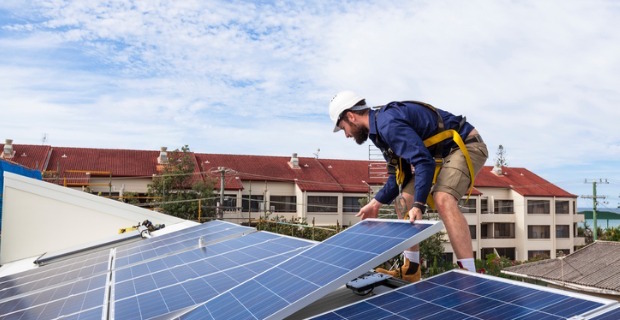
 Australians who invested in a rooftop solar systems over the month of May are set to save a combined $233 million in energy bill savings over the next decade, a new report has found, as households and small business continue to install PV in record numbers.
Australians who invested in a rooftop solar systems over the month of May are set to save a combined $233 million in energy bill savings over the next decade, a new report has found, as households and small business continue to install PV in record numbers.
The savings are forecast as part of the latest Renewable Energy Index report from Green Energy Markets, which records another 18,917 small-scale solar systems installed around Australia in the month of May – enough combined capacity to power 38,203 homes.
GEM says the savings – illustrated in the chart above – were calculated using data on the number of small-scale technology certificates registered by the Clean Energy Regulator, for the estimated average annual power generation from solar PV systems installed in each state.
To determine how much of this generation would displace imported power from the grid at retail rates, or would be exported to the grid for a feed-in tariff, systems were sorted into different kilowatt size categories, the report says.
The amount exported by solar power systems rises from 50 per cent for 2kW systems up to 90 per cent for 8-10kW systems, based on advice from the Alternative Technology Association, GEM says.
Systems larger than 15kW are assumed to only avoid or receive an electricity rate equal to the export feed-in tariff we estimate for residential customers in each state, the report says.
As we reported here, May has been chalked up as yet another huge month for rooftop solar installations in Australia, with a new monthly record rate of 131.7MW marking the eighth consecutive month of installs topping 100MW.
This momentum has pushed Australia’s small solar installs – including solar hot water systems – past the 3 million mark, to a point where one in five Australian households were generating at least some of their own power.
According to the Clean Energy Regulator, this means Australia’s households and small businesses have installed enough capacity to generate – or in the case of solar hot water, to displace – around 12.9 million megawatt-hours of electricity a year.
“This is another milestone demonstrating Australians are making the most of the Small-scale Renewable Energy Scheme to access clean, renewable energy systems,” said CER executive general manager Mark Williamson.
“One in five Australian homes now generate their own renewable energy and reduce carbon emissions through rooftop solar,” he said.
But beyond the record books – and the huge savings to had for consumers – the numbers tell a bigger story; of the huge transformation currently taking pace in Australia’s grid that will see small-scale solar account for nearly half of the nation’s generation supply in just a couple of decades.
And as part of this transformation, Australian homes and small businesses will become a crucial player in the National Electricity Market, and in delivering a cheaper, cleaner, and more efficient power supply for all.
“At the distributed network level… you can expect that roughly 40 per cent of the installed capacity of generation by 2040 will come from solar installed in houses, on roofs, and stored in batteries, in EVs in driveways,” said the CEO of ARENA, Ian Kay, on Wednesday.
The way all of this distributed and stored solar generation is controlled will quickly become very important, Kay said, as will control over the combined load of the nation’s millions of air-conditioners and pool pumps will be just as crucial to balancing the grid.
According to Kay, who was speaking at the Large-scale Solar and Storage conference in Sydney on Thursday – a conference co-hosted by RenewEconomy and Informa – a mind-bending 4GW of electrical output is dedicated to running the nation’s pool pumps.
“So the way that gets controlled is going to be very important,” Kay said.
“The focus is now turning to how the power’s going to wash through the system, from one end to the other, rather than thinking about individual (generators), as we do now,” he told the conference.
“There’s going to be a lot of software solutions, with power use in homes controlled in way that helps balance the system.”

Sophie is editor of One Step Off The Grid and deputy editor of its sister site, Renew Economy. Sophie has been writing about clean energy for more than a decade.
